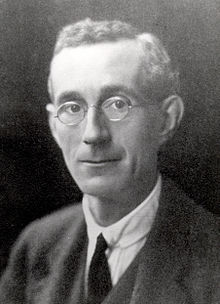Robert John Tillyard
| Robert John Tillyard | |
|---|---|
 |
|
| Born |
31 January 1881 Norwich, England |
| Died | 13 January 1937 (aged 55) Goulburn, Australia |
| Alma mater |
Queens' College, Cambridge University of Sydney |
| Notable awards | Clarke Medal (1931) |
| Spouse | Patricia Cruske |
| Children | 4 daughters |
Robert "Robin" John Tillyard FRS (31 January 1881 – 13 January 1937) was an English–Australian entomologist and geologist.
Tillyard was the son of J. J. Tillyard and his wife Mary Ann Frances, née Wilson and was born at Norwich, Norfolk. He was educated at Dover College and intended to enter the army but was rejected on account of having suffered from rheumatism. He won a scholarship for classics at Oxford and another for mathematics at Cambridge, and decided to go to Queens' College, Cambridge. He graduated senior optime in 1903. He went to Australia in 1904 and was appointed second mathematics and science master at Sydney Grammar School. Nine years later he resigned and did a research degree in biology at Sydney University and took his research B.Sc. degree in 1914.
He was seriously injured in a railway accident in 1914 and had a slow recovery, but in 1915 became Linnean Macleay Fellow in Zoology at the University of Sydney. He was appointed lecturer in Zoology in 1917. In the same year he published in the Cambridge Zoological series, The Biology of Dragonflies, and he also received the Crisp prize and medal of the Linnean Society of London. In 1920 he was appointed chief of the department of biology at the Cawthron Institute, Nelson, New Zealand. In the same year the honorary degree of D.Sc. was conferred on him by Cambridge University.
Tillyard did good work in New Zealand and established a reputation for his work on the biological control of plant and insect pests. He is popularly best known for his introduction of a small wasp as an agent for controlling woolly aphis in apple-trees. In 1925 he was elected a fellow of the Royal Society, London, and in the following year he published his book on The Insects of Australia and New Zealand, a comprehensive work with many illustrations. This book became the standard work on Australasian entomology for some fifty years. He published widely and authoritatively on Odonata, Plecoptera, Neuroptera, and other orders, and on fossil insects, the wing venation of insects, and the phylogeny of insects. In this year he was awarded the Trueman Wood medal of the Royal Society of Arts and Science, London, and was appointed assistant-director of the Cawthron Institute.
...
Wikipedia
